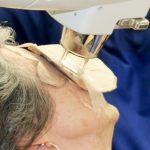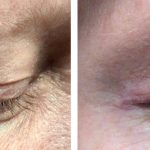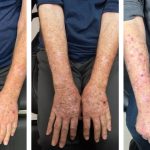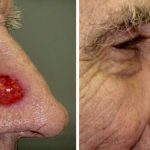Radiation Therapy of Skin Cancer: Dosing and Complications
Although, radiation of ear carcinomas can pose a risk of chondritis and poor healing, that risk can be virtually eliminated with lower dose fractions (radiation dose per treatment) spread over a longer course. Total dose requirement for skin cancer treatment ranges from 3500 cGy to 6000 cGy depending on the size and depth of the cancer. Instead of 10 fractions of 350 – 600 cGy, the course could be 25-30 fractions of 200-250 cGy – delivered more slowly to a higher dose. Treatment is performed 5 days a week resulting in a 6 week course with 30 fractions. Thin lesions can be treated quicker with lower total dose and higher dose per fraction.
Over 350 cGy per fraction, chronic changes occur in the tissue – hypopigmentation, atrophy (with wrinkling and depression), fibrosis, telangiectasias, alopecia, and rarely ulceration. In many skin locations this may not be a problem. However, in areas of ear and nasal cartilage, the complications of higher dose per fraction (i.e. quicker treatment course) results in additional treatment months later such as debridement of chondritis-damaged cartilage. For many patients, surgery is more expedient but radiation plays a vital role as an alternative.
The risk of radiation induced transformation of basosquamous cell carcinoma into a more aggressive variant was brought up. This was disputed in favor of a more current view of this phenomena. In a setting of polyclonal cancer cell lines, if radioresistant cell lines are present, they are the ones more likely to survive radiation treatment and emerge as the residual carcinoma. Mutation of cell lines with radiation is a phenomena that occurs 15+ years after exposure of skin to radiation.






